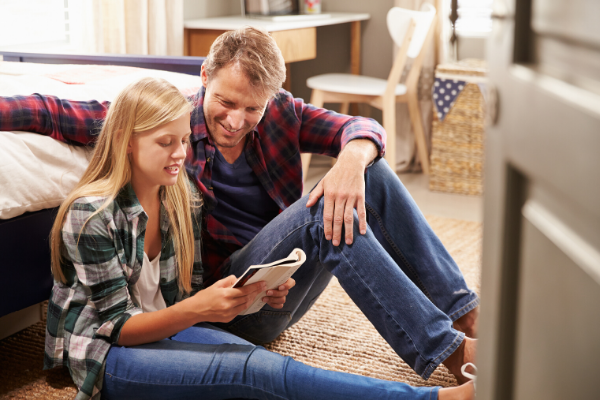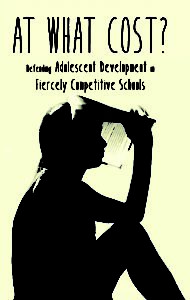Ironically, in the Covid-19 pandemic, schools and families have been forced to make massive reactive changes, ones they could never have imagined had this crisis not occurred. While most of these new ways of living and learning are unsettling and distressing, I’ve observed glimmers of silver linings and perhaps some culture changes that may be worth holding onto.
Take, for example, one of the most frequently identified problems in high-performance, hyper schooling culture — the overscheduled nature of students’ everyday lives. I explored many of the negative consequences of this culture in my book, At What Cost? Defending Adolescent Development in Fiercely Competitive Schools.
The shift to online academics and halt of extracurricular activities have transformed students’ time, even in the most high-pressured school environments:
- academic schedules have been reduced because of the nature of constant online learning;
- grades in most schools and colleges have been changed to a pass/fail status;
- all extracurricular activities and after-school sports have been canceled.
Even the Advanced Placement exam has been transformed into an online 45-minute test that students take from home. Of course, this doesn’t remove the stress involved in studying and wondering what one’s score will be; that uncertainty remains.
Another aspect of students’ pre-pandemic lives linked to overscheduling was insufficient sleep. As I’ve said many times, chronic sleep deprivation – in adolescents and adults alike – manifests in a variety of unhealthy and dangerous ways, such as chronic anxiety, car accidents, and depression.
Now, however, with no early morning commute to school or several hours of extracurricular activities, many high school students are able to sleep more than the recommended eight or nine hours per night. One parent with whom I’ve spoken recently reported that her teenage son has been sleeping up to 12 hours per night on a regular basis. Consistent with an adolescent’s natural circadian rhythm, his sleep schedule is from 1:00 a.m. to 1:00 p.m.!
Further, as if it hadn’t already been popular, the practice of mindfulness meditation has probably never been more in demand. Because of heightened anxiety and stress levels about the pandemic, many students, teachers, administrators, and parents alike are turning to the practice of mindfulness to offset their hyper-aroused states of anxiety.
In each of the many webinars I’ve presented lately, I’ve polled participants about the stress they’re experiencing and observing:
- What signs of symptoms of stress are you observing in your colleagues or experiencing yourself?
- In what ways you have been trying to cope with your stressful feelings?
Most strikingly – but not surprisingly – is that “anxiety” has been the most frequently reported symptom of stress and that “spending more time with family and friends” has been the most frequently reported strategy for coping with this stress.
A Healthier Balance for Students and Families?
Is it possible that individuals and families are re-establishing old – but new to them now – habits of prioritizing time with family and friends over relentless hours of work? Although temporary at this point, are individuals and families striking a new and healthier balance between work and play or between work and relationships? According to Sigmund Freud, “Love and work are the cornerstones of our humanness!” Could it be that a silver lining is emerging from this world-wide crisis — that we are reconnecting with a healthier balance between “love and work?”
While this new balance certainly has its downsides – students are missing in-person interactive class discussions and socialization; graduating seniors are missing out on traditional and time-honored rituals and celebrations; and social distancing has led to increased social isolation, anxiety, and loneliness for many – there may still be aspects of this massive period of change that may be worth keeping and continuing.
As this pandemic and its restrictive living conditions continue for the near future, at some point, we need to ask ourselves how much of the pre-pandemic “status quo” do we want to return to? How will the future of education and work-life balance unfold in light of the massive changes that schools, businesses, and families around the world have had to make?
Once communities and schools begin to reopen, will we – administrators, teachers and parent — strive to keep our students “developmental integrity” in mind or will we rush back to the overscheduled and sleep-deprived conditions that characterized children’s and adolescents’ lives just a few months ago?
Maybe the hyper-schooling culture of the past doesn’t have to be so “hyper” after all? Maybe courses – even AP and IB courses – can be taught in such a way that both deliver meaningful content and allow students to get the sleep they need for their health and wellbeing. Maybe students could be granted more unstructured time, time we now know from neuroscience that students need not only to socialize with one another but also to rest, dream, and imagine their futures.
While we have always been responsible for the cultures we have created, over the past few months, we have had to create an entirely different culture – one that is certainly challenging, often filled with anxiety and not sustainable for the long run. However, this new culture may have a few silver linings that may be worth keeping.
As a colleague noted in a recent video meeting of professionals, “This crisis is not the end, it is a pause.” [1] We adults are still responsible for the cultures we create. Now that we’ve made massive changes not only to how we educate our students, but also how we’re living our own lives, once this pandemic-induced pause is behind us, I welcome your thoughts and ideas:
What surprisingly joyful or positive encounters have you experienced or witnessed that may be worth keeping or continuing?
How might we begin to imagine living and learning more broadly?
What matters most to you?
[1] https://www.mobiusleadership.com/executive_team/catherine-a-cotins/


